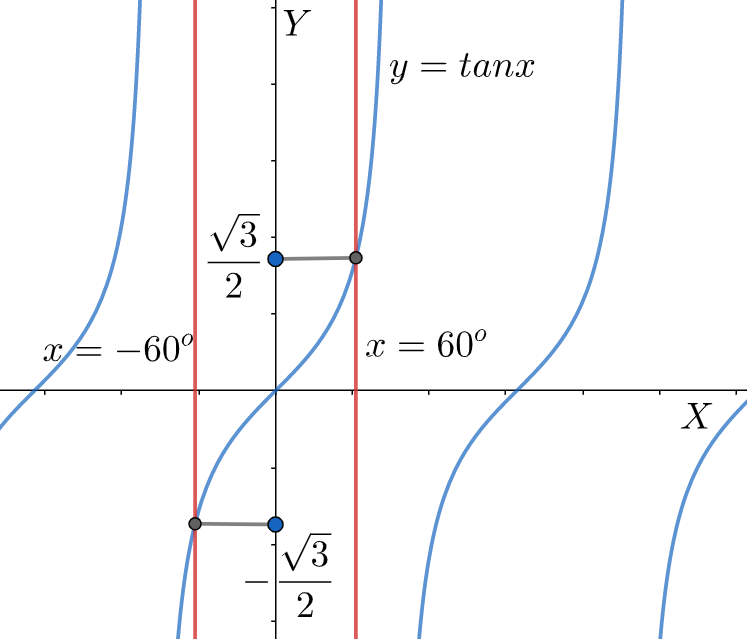
How do you prove that tangent is an odd function?
Answer
540k+ views
Hint: We first draw the graph of $\tan x$ . After that we take two lines $x={{60}^{\circ }}$ and $x=-{{60}^{\circ }}$ . We note the ordinates of the two points of intersection which are negative. So, $\tan x$ is an odd function.
Complete step-by-step answer:
Functions can be odd or even functions. According to definition, a function is said to be even if $f\left( -x \right)=f\left( x \right)$ , which means that irrespective of the sign (positive or negative) of the independent variable $x$ , the value of the function does not change. On the other hand, if $f\left( -x \right)=-f\left( x \right)$ , then the function is said to be an odd function, which means that as the sign of the independent variable $x$ changes, the sign of the function changes too.
In this given problem, we need to prove that tangent is an odd function. By tangent, we mean $\tan x$ . We can prove this statement graphically. We first draw the graph of $\tan x$ .

Let us first investigate the nature of the function at some $x>0$ , say ${{60}^{\circ }}$ . So, we need to take $x={{60}^{\circ }}$ line. The point where this $x={{60}^{\circ }}$ line cuts the $\tan x$ graph is $\left( {{60}^{\circ }},\dfrac{\sqrt{3}}{2} \right)$ , which means that the value of $\tan x$ is positive at $x={{60}^{\circ }}$ .
We see that the value of $\tan x$ at ${{60}^{\circ }}$ is positive. Now, we need to take another $x<0$ whose magnitude is equal to the previous positive $x$ taken. So, we need to take the $x=-{{60}^{\circ }}$ line. The point where this $x=-{{60}^{\circ }}$ line cuts the $\tan x$ graph is $\left( -{{60}^{\circ }},-\dfrac{\sqrt{3}}{2} \right)$ . This means that the value of $\tan x$ is negative at $x=-{{60}^{\circ }}$ .
Therefore, we can prove that tangent is an odd function as the two values of $\tan x$ at two values of $x$ , one being positive and the other being negative, are of opposite signs.
Note: The graph of $\tan x$ should be drawn correctly. We should remember to take only two such values of $x$ which have equal magnitude but opposite signs. We can also have the traditional method of proving it odd by showing that $\tan x$ is negative in the fourth quadrant, thus it is an odd function.
Complete step-by-step answer:
Functions can be odd or even functions. According to definition, a function is said to be even if $f\left( -x \right)=f\left( x \right)$ , which means that irrespective of the sign (positive or negative) of the independent variable $x$ , the value of the function does not change. On the other hand, if $f\left( -x \right)=-f\left( x \right)$ , then the function is said to be an odd function, which means that as the sign of the independent variable $x$ changes, the sign of the function changes too.
In this given problem, we need to prove that tangent is an odd function. By tangent, we mean $\tan x$ . We can prove this statement graphically. We first draw the graph of $\tan x$ .

Let us first investigate the nature of the function at some $x>0$ , say ${{60}^{\circ }}$ . So, we need to take $x={{60}^{\circ }}$ line. The point where this $x={{60}^{\circ }}$ line cuts the $\tan x$ graph is $\left( {{60}^{\circ }},\dfrac{\sqrt{3}}{2} \right)$ , which means that the value of $\tan x$ is positive at $x={{60}^{\circ }}$ .
We see that the value of $\tan x$ at ${{60}^{\circ }}$ is positive. Now, we need to take another $x<0$ whose magnitude is equal to the previous positive $x$ taken. So, we need to take the $x=-{{60}^{\circ }}$ line. The point where this $x=-{{60}^{\circ }}$ line cuts the $\tan x$ graph is $\left( -{{60}^{\circ }},-\dfrac{\sqrt{3}}{2} \right)$ . This means that the value of $\tan x$ is negative at $x=-{{60}^{\circ }}$ .
Therefore, we can prove that tangent is an odd function as the two values of $\tan x$ at two values of $x$ , one being positive and the other being negative, are of opposite signs.
Note: The graph of $\tan x$ should be drawn correctly. We should remember to take only two such values of $x$ which have equal magnitude but opposite signs. We can also have the traditional method of proving it odd by showing that $\tan x$ is negative in the fourth quadrant, thus it is an odd function.
Recently Updated Pages
Master Class 12 Economics: Engaging Questions & Answers for Success

Master Class 12 Maths: Engaging Questions & Answers for Success

Master Class 12 Biology: Engaging Questions & Answers for Success

Master Class 12 Physics: Engaging Questions & Answers for Success

Master Class 8 Maths: Engaging Questions & Answers for Success

Class 8 Question and Answer - Your Ultimate Solutions Guide

Trending doubts
What is meant by exothermic and endothermic reactions class 11 chemistry CBSE

10 examples of friction in our daily life

One Metric ton is equal to kg A 10000 B 1000 C 100 class 11 physics CBSE

1 Quintal is equal to a 110 kg b 10 kg c 100kg d 1000 class 11 physics CBSE

Difference Between Prokaryotic Cells and Eukaryotic Cells

What are Quantum numbers Explain the quantum number class 11 chemistry CBSE




